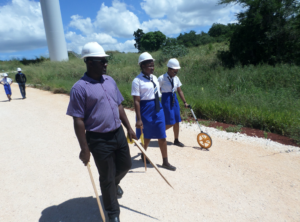Wherever we operate, we seek ways to engage with the surrounding communities to share the benefits of renewable energy.
In the U.S., the practice of studying a wind facility’s impact on local wildlife is fairly well-known. We recognized that this process would be especially important for our Jamaica Wind facility in the Caribbean, where islands serve as a habitat for various kinds of birds and bats including rare and endangered species. To share our experience in developing wind farms in the United States, we collaborated with local school groups to collect data on our facility’s impact on the wildlife using guidelines set forth by the U.S. Fish and Wildlife Service and Army Corps of Engineers. Working with locals schools and students presented us with an opportunity to demonstrate leadership within the industry and create a space for students to learn about renewable energy and wildlife, all while assisting in general knowledge transfer.
To begin the program in Jamaica, where a study like this had never been done, we leveraged the expertise of Dr. Paul Kerlinger, a retired ornithologist and bird migration expert. Dr. Kerlinger had previous experience overseeing how wind farms and other man-made structures in the U.S. affected bird migrations. We knew he’d play an instrumental role in our study as he’s helped devise and implement post-construction avian mortality studies like this for over 10,000MWs of installed wind turbine capacity in North America.
We paired Dr. Kerlinger’s expertise with teams of 20 local student interns from Munro College and Hampton School in nearby St. Elizabeth. After extensive training at our wind farm led by Dr. Kerlinger, the students visited the facility on a bi-weekly basis, to walk the Jamaica Wind grounds to search for and identify birds and bats that may have been impacted by the 11 wind turbines.

The student groups conducted their research during the Fall and Spring seasons from 2016 to 2019, and completed a total of nearly 300 searches. They explored the changes in avian mortality rates across different seasons and assessed the impact of mortality rates on each species’ migratory patterns and total population. With leadership from the students, the team put together a report summarizing their process, results and analysis of their research.
Through the study, BMR was able to determine that the high grasses surrounding the turbines housed insects and made for a feeding ground for the birds and bats. By controlling the vegetation on the site, less birds frequented the site and the students found that the number of mortalities decreased by 50 percent.
BMR valued the opportunity to teach students about what’s happening right in their own neighborhood, support student development of tangible, transferable skills and spark curiosity that may lead them to work in our industry.
This program opened the door for students to gain first-hand experiences with renewable energy technology, creating an immediate and local opportunity for them to practice their research skills right in their backyard. We owe a big thanks to our student participants and look forward to continuing to find ways to work together in the future.